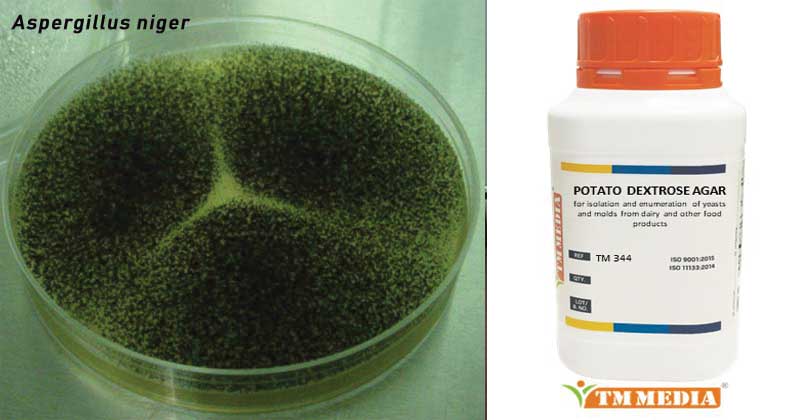Interesting Science Videos
What is a Potato Dextrose Agar (PDA)?
Potato dextrose agar (PDA) is common microbiological basal growth media made from potato infusion, and dextrose is used for the growth of the fungi. Potato Dextrose Agar is recommended by APHA and FDA for plate counts of yeasts and molds in the examination of foods and dairy products. It is a general-purpose medium for yeasts and molds that can be supplemented with acid or antibiotics like Chloramphenicol, Tartaric Acid and Chlortetracycline can be added as selective agents to inhibit bacterial growth. PDA can be used for growing clinically significant yeast and molds. Potato Dextrose Agar is also useful for maintaining stock cultures of certain dermatophytes.
Composition of Potato Dextrose Agar (PDA)
| Ingredients | Gms/L |
| Potatoes, infusion from | 200.0 |
| Dextrose | 20.0 |
| Agar | 15.0 |
Final pH ( at 25°C) 5.6±0.2
Principle of Potato Dextrose Agar (PDA)
Potato Dextrose Agar (PDA) contains dextrose as a carbohydrate source which serves as a growth stimulant and potato infusion that provides a nutrient base for luxuriant growth of most fungi. Agar is added as the solidifying agent. A specified amount of sterile tartaric acid (10%) may be incorporated to lower the pH of the medium to 3.5 so that bacterial growth is inhibited.
Preparation of Potato Dextrose Agar (PDA)
- Suspend 39 grams in 1000 ml distilled water. Heat to boiling to dissolve the medium completely.
- Sterilize by autoclaving at 15 lbs pressure (121°C) for 15 minutes. Mix well before dispensing.
- In specific work, when pH 3.5 is required, the medium should be acidified with sterile 10% tartaric acid.
- The amount of acid required for 100 ml. of sterile, cooled medium is approximately 1ml.
- Do not heat the medium after addition of the acid.
Result Interpretation of Potato Dextrose Agar (PDA)
Yeasts will grow as creamy to white colonies.
Molds will grow as filamentous colonies of various colors.

Colony morphology of some fungi on Potato Dextrose Agar (PDA)
| Fungi | Texture | Surface color | Reverse color | Zonation | Sporulation |
| Aspergillus candidus | Velvety thick | Creamy white | Slightly creamy | Radially furrowed on the reverse | Moderate |
| Aspergillus niger | Velvety | White with typical black spores | yellow | Heavily furrowed on the reverse | Heavy |
| Aspergillus sulphureus | Velvety | Dirty white with yellow spores at the center | Orange to chocolate color | Slightly radially furrowed | Moderate |
| Penicillium corylophilum | Velvety | Dark green | Colorless to Creamy | With shallow center and radially furrowed raised margin | Moderate |
| P. expansum | Velvety | Dark green with clear exudates and distinct sterile white margin | Yellow | Radially furrowed | Heavy |
| Fusarium oxysporum | Floccose | Magenta pink | Magenta-red turning violet | With concentric zones of dark and light reddish coloration | Poor |
Uses of PDA
- It is used for the detection of yeasts and molds in dairy products and prepared foods.
- It may also be used for the cultivation of yeasts and molds from clinical specimens.
- PDA with TA (Tartaric Acid) is recommended for the microbial examination of food and dairy products.
- PDA with Chlortetracycline is recommended for the microbial enumeration of yeast and mold from cosmetics.
- PDA with Chloramphenicol is recommended for the selective cultivation of fungi from mixed samples.
Limitations of PDA
- It is recommended that biochemical, immunological, molecular, or mass spectrometry testing be performed on colonies from pure culture for complete identification.
References
- Potato Dextrose Agar (PDA). TM Media.
- http://legacy.bd.com/ds/technicalCenter/inserts/8801441(03).pdf
- https://www.emdmillipore.com/Web-CA-Site/en_CA/-/CAD/ShowDocument-File?ProductSKU=MDA_CHEM-110130&DocumentId=201602.369.ProNet&DocumentUID=28219545&DocumentType=DS&Language=EN&Country=NF&Origin=PDP
- https://www.fishersci.com/shop/products/potato-dextrose-agar-500g/502015204
- http://www.oxoid.com/UK/blue/prod_detail/prod_detail.asp?pr=CM0139&cat=&c=UK&lang=EN
- https://wiki.bugwood.org/Acid_potato_dextrose_agar
- https://www.eurofins-technologies.com/bacgro-potato-dextrose-agar-500-g.html
- https://www.carolina.com/dehydrated-media-and-media-ingredients/potato-dextrose-agar-dehydrated-medium-500-g/786341.pr
- https://www.wardsci.com/store/product/8884588/ward-s-prepared-potato-dextrose-agar
- https://www.merckmillipore.com/DE/de/product/Potato-dextrose-agar,MDA_CHEM-110130
- https://www.neogen.com/categories/microbiology/potato-dextrose-agar/
- https://www.sigmaaldrich.com/DE/de/product/sial/p2182
- https://www.thermofisher.com/order/catalog/product/CM0139B
- https://www.fda.gov/food/laboratory-methods-food/bam-media-m127-potato-dextrose-agar
- https://www.mpbio.com/eu/091008517-potato-dextrose-agar
- https://www.invasive.org/browse/hostimages.cfm?host=22885

Pls can I get the citation and references of potatoes dextrose agar
To make PDA a selective medium and differential medium what can I add on it
thanks for your help other community.
can i get more info and study notes on this its intresting as i find more then just intoduction here on topics on culture
Plz share PDA Supplimented with antibiotics preparation .